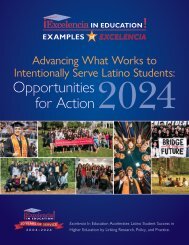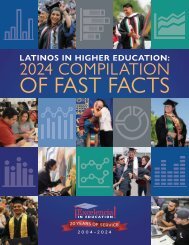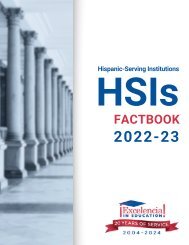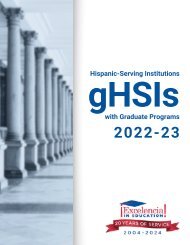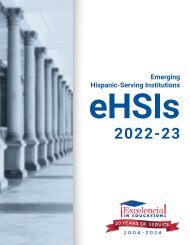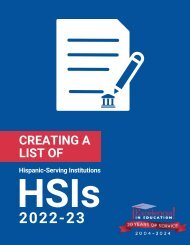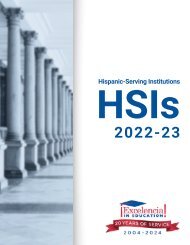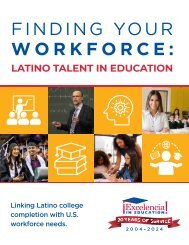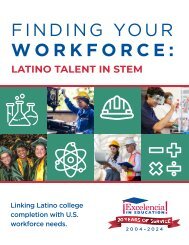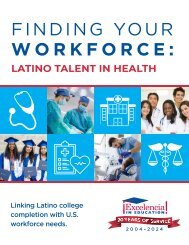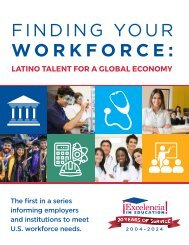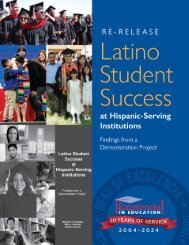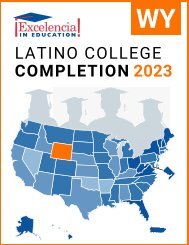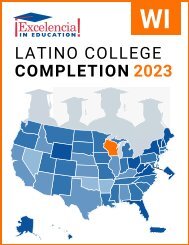Latino College Completion 2023: Missouri
You also want an ePaper? Increase the reach of your titles
YUMPU automatically turns print PDFs into web optimized ePapers that Google loves.
MO
LATINO COLLEGE COMPLETION:<br />
MISSOURI – <strong>2023</strong><br />
For the U.S. to regain the top ranking in the world for college degree<br />
attainment, <strong>Latino</strong>s will need to earn 6.2 million degrees by 2030. 1<br />
FAST FACTS<br />
STATE RANKING:<br />
<strong>Missouri</strong> had the 30th largest<br />
<strong>Latino</strong> population in the U.S.<br />
K-12 POPULATION:<br />
In <strong>Missouri</strong>, 7% of the K-12<br />
population was <strong>Latino</strong>. 2<br />
POPULATION:<br />
In <strong>Missouri</strong>, 5% of the population<br />
was <strong>Latino</strong>. 2<br />
MEDIAN AGE:<br />
The median age<br />
of Hispanics in<br />
<strong>Missouri</strong> was 26,<br />
compared to 41<br />
for White non-<br />
Hispanics. 2<br />
26<br />
Hispanics<br />
41<br />
White<br />
non-Hispanics<br />
ENROLLMENT:<br />
In <strong>Missouri</strong>, 21% of Hispanics<br />
(ages 18 to 34) were enrolled in higher<br />
education, compared to 22% of<br />
White non-Hispanics. 2<br />
DEGREE ATTAINMENT:<br />
In <strong>Missouri</strong>, 30% of Hispanic<br />
adults (25 and older) had earned an<br />
associate degree or higher, compared to<br />
41% of White non-Hispanic adults. 2<br />
Hispanic Adults = 3.0 of 10<br />
White Adults = 4.1 of 10<br />
To reach the degree attainment goal by 2030, the U.S. can: close<br />
the degree completion gap by accelerating <strong>Latino</strong> completion while<br />
increasing for all students and scale up programs and initiatives that<br />
work for <strong>Latino</strong>, and all, students. The following demographics,<br />
institutional data, and practices inform <strong>Latino</strong> degree attainment.<br />
ENROLLING: Top 5 Institutions (Hispanic Undergraduates) in <strong>Missouri</strong>, 2021-22<br />
Institution<br />
Sector<br />
Grand<br />
Total<br />
Hispanic<br />
Total<br />
Source: Excelencia in Education analysis using U.S. Department of Education, National Center for<br />
Education Statistics (NCES), Integrated Postsecondary Education Data System (IPEDS), 2021 Fall<br />
Enrollment, Graduation Rates Survey and Institutional Characteristics Survey.<br />
%<br />
Hispanic<br />
Private not-forprofit,<br />
4-year<br />
1 Park University<br />
7,131 1,659 23%<br />
Metropolitan Community <strong>College</strong>-Kansas<br />
2 City<br />
Public, 2-year 11,784 1,576 13%<br />
3 University of <strong>Missouri</strong>-Columbia Public, 4-year 23,092 1,210 5%<br />
Private not-forprofit,<br />
4-year<br />
4 Washington University in St Louis<br />
7,713 854 11%<br />
5 University of <strong>Missouri</strong>-Kansas City Public, 4-year 6,762 852 13%<br />
ASSOCIATE DEGREES: Top 5 Institutions Awarding to Hispanics in <strong>Missouri</strong>, 2020-21<br />
Institution<br />
Sector<br />
Grand<br />
Total<br />
Hispanic<br />
Total<br />
%<br />
Hispanic<br />
Metropolitan Community <strong>College</strong>-Kansas<br />
1 City<br />
Public, 2-year 1,856 190 10%<br />
Private not-forprofit,<br />
4-year<br />
2 Columbia <strong>College</strong><br />
817 104 13%<br />
3 Saint Louis Community <strong>College</strong> Public, 2-year 2,055 84 4%<br />
4 Ozarks Technical Community <strong>College</strong> Public, 2-year 1,598 77 5%<br />
5 Crowder <strong>College</strong> Public, 2-year 643 52 8%<br />
BACHELOR DEGREES: Top 5 Institutions Awarding to Hispanics in <strong>Missouri</strong>, 2020-21<br />
Institution<br />
Sector<br />
Grand Hispanic %<br />
Total Total Hispanic<br />
Private not-forprofit,<br />
4-year<br />
1 Park University<br />
1,687 387 23%<br />
2 University of <strong>Missouri</strong>-Columbia Public, 4-year 4,742 230 5%<br />
Private not-forprofit,<br />
4-year<br />
3 Washington University in St Louis<br />
1,891 190 10%<br />
Private not-forprofit,<br />
4-year<br />
4 Columbia <strong>College</strong><br />
1,646 174 11%<br />
5 University of <strong>Missouri</strong>-Kansas City Public, 4-year 1,764 162 9%<br />
NOTE: We use the terms <strong>Latino</strong> and Hispanic interchangeably in this factsheet.<br />
1 Projections to 2030: Excelencia in Education. (2020). Ensuring America’s Future: Benchmarking <strong>Latino</strong><br />
<strong>College</strong> <strong>Completion</strong> to 2030. Excelencia in Education. Washington, D.C.<br />
2 U.S. Census Bureau, 2021 American Community Survey 1-Year Estimates
<strong>Missouri</strong> Gap in Degree <strong>Completion</strong><br />
Closing the degree completion gap can be tracked<br />
by the 4 measures shown below. Alone, none<br />
of these measures capture the entire “story” of<br />
degree completion. However, in combination,<br />
they provide a useful picture of the gap in degree<br />
attainment between Hispanic and White non-<br />
Hispanic cohorts in a single year.<br />
Graduation Rate — Total percentage of students<br />
who graduated within 150% of normal time for<br />
first-time, full-time freshmen. This incorporates<br />
students that graduated in 3 years at two-year<br />
institutions, or in 6 years at four-year institutions.<br />
Transferred to Another Institution —<br />
Percentage of students that transferred to another<br />
institution and did not complete a degree.<br />
Still Enrolled — Percentage of students that are<br />
still enrolled at the point of 150% normal time to<br />
completion.<br />
No Longer Enrolled — Percentage of students<br />
that are no longer enrolled at the point of 150%<br />
normal time to completion.<br />
At two-year institutions, Hispanics’<br />
graduation rate was 7%-points<br />
lower than that of their White<br />
non-Hispanic peers in <strong>Missouri</strong>.<br />
TWO-YEAR INSTITUTIONS<br />
40%<br />
8%<br />
15%<br />
37%<br />
WHITE<br />
-7%<br />
48%<br />
12%<br />
11%<br />
30%<br />
HISPANIC<br />
DEGREE OUTCOMES<br />
■ No Longer Enrolled<br />
■ Still Enrolled<br />
■ Transferred to<br />
Another Institution<br />
■ Graduation Rate<br />
*Percentages may not add up to 100% due to rounding.<br />
At four-year institutions, Hispanics’<br />
graduation rate was 6%-points<br />
lower than that of their White<br />
non-Hispanic peers in <strong>Missouri</strong>.<br />
FOUR-YEAR INSTITUTIONS<br />
WHITE<br />
-6%<br />
HISPANIC<br />
NOTE: Outcomes shown are for students at two-year institutions who started in Fall 2018, and<br />
for students at four-year institutions who started in Fall 2015.<br />
Source: Excelencia in Education analysis using the U.S. Department of Education, National<br />
Center for Education Statistics (NCES), Integrated Postsecondary Education Data System, 2021<br />
Graduation Rates Survey and the Institutional Characteristics Survey.<br />
1%<br />
26%<br />
8%<br />
64%<br />
1%<br />
32%<br />
8%<br />
58%<br />
Examples of What Works for <strong>Latino</strong> Students<br />
There are institutions showing success in enrolling, retaining, and graduating <strong>Latino</strong> students. The following are examples of<br />
programs across the country with evidence of effectiveness in serving <strong>Latino</strong> students nominated for Examples of Excelencia.<br />
The San Antonio <strong>College</strong> Honors Academy Program provides<br />
underserved community college students, the majority of whom are<br />
<strong>Latino</strong>, honors-designated core courses, comprehensive academic<br />
services, one-on-one guidance by dedicated professors/advisors,<br />
scholarship and transfer support. The Honors Academy Program seeks to<br />
increase the number of underserved students who receive an associate<br />
degree and transfer to a four-year university. Established in 2012, the<br />
Academy was founded to replace the former honors program that served<br />
just a few dozen students. In 2012, the Jessie Ball DuPont Fund awarded<br />
a 3-year grant to support a new focus on recruiting a larger, more<br />
diverse population of students, particularly those in neighboring inner-city,<br />
at-risk Title I/III schools which are 60-90% <strong>Latino</strong>. The Academy offers<br />
specialized honors curriculum centered on identity, communication,<br />
teamwork, marketable skills, critical thinking, and research. Participants<br />
receive intrusive advising/mentoring that emphasizes clear pathways to<br />
graduation/transfer and are offered workshops on transfer admissions,<br />
career choice, stress/time management, scholarships, and internships.<br />
Aside from taking honors-designated core subject courses to earn honors<br />
course equivalencies, students can complete semester-long experiential<br />
learning opportunities. Participants also have access to an Honors Center<br />
with study space, 20 computers, a printer, lounge area, kitchenette, and<br />
faculty offices for advising and engagement. The Academy also offers a<br />
Strategies for Success course emphasizing time management, grit, fluid<br />
intelligence, and goal setting for participants whose GPA falls below 3.25.<br />
Hispanic participants are over 67% of those enrolled in the program and<br />
transfer at a much higher rate than Hispanic non-particiants.<br />
• Of the Academy’s Fall 2016 cohort, 42% of program participants<br />
graduated in 3 years compared to only 28% of non-program participants<br />
• Of the Academy’s Fall 2015 cohort, 49% of program participants<br />
graduated in 3 years compared to only 29% of non-program participants<br />
• Of the Academy’s Fall 2013 cohort, 46% of program participants<br />
transferred within 6 years compared to the institutional average of 30%<br />
• Of the Academy’s Fall 2012 cohort, 73% of program participants<br />
transferred within 6 years compared to the institutional average of 30%<br />
For more information on institutional programs improving <strong>Latino</strong> student success in higher education, access Excelencia in<br />
Education’s Growing What Works database at http://www.edexcelencia.org/growing-what-works<br />
ENSURING AMERICA’S FUTURE BY INCREASING LATINO COLLEGE COMPLETION • WWW.EDEXCELENCIA.ORG




